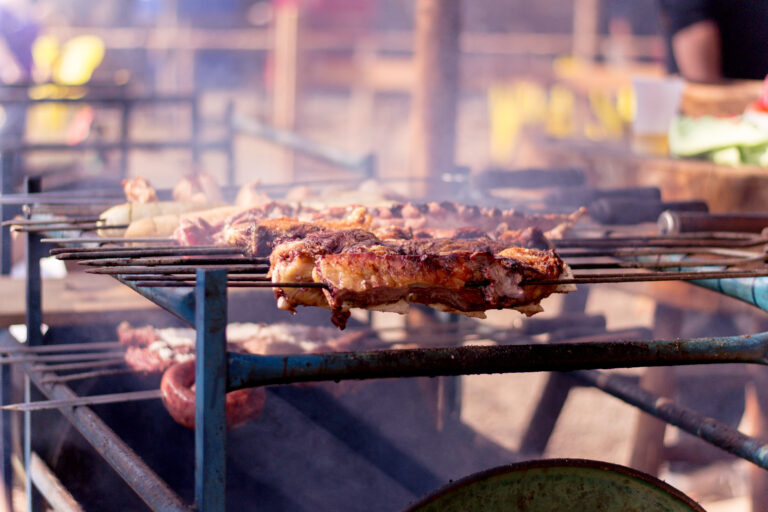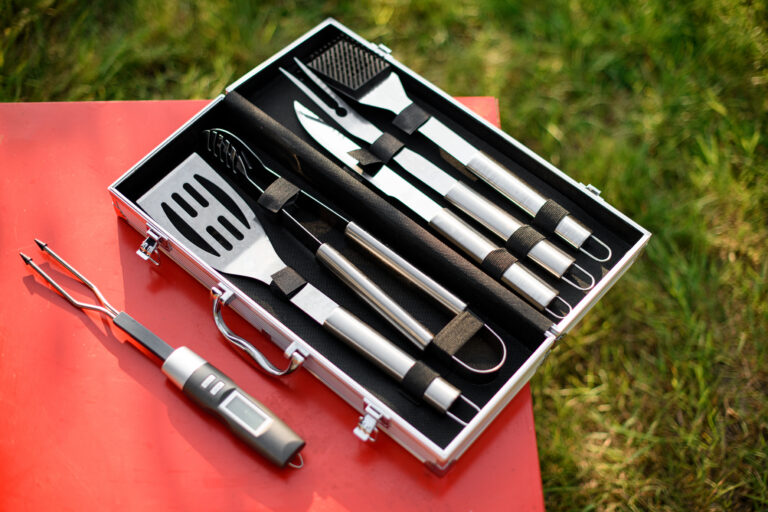7 Reasons Why Cleavers Have Holes for Safer and Easier Kitchen Use
Cleavers have holes for easy hanging, not weight reduction. They’re versatile tools for meat, fruits, and even smashing, with different designs for various kitchen tasks.

One knife is not like the others. Besides being the only knife with a hole in the blade, a cleaver knife has quite a few other quirks that make it the odd one out.
Discover the practical and handy reason for that hole and why cleavers are perhaps the most useful yet woefully under-utilized tool in the kitchen.
Disclosure: As an Amazon Associate, this site earns from qualifying purchases. Thank you!
So, Why Do Cleavers Have Holes?
Tradition and function. Today most manufacturers of cleavers for home cooks add a hole through the corner of the blade opposite the handle simply as a stylistic choice. However, that wasn’t always the case.
A Nod to the Past
Before butchers used bandsaws to break down meat, they depended on their cleavers to do the cutting.
Butchering is a bloody business, and keeping a sharp and heavy knife on a slippery work surface where it can fall isn’t safe a safe option. The ability for butchers to store cleavers securely off of the table yet within easy reach was important.
Old-time butchers being practical people, knew that hanging was the easiest way to store the knife in a limited workspace.
But since attaching a loop to the cleaver’s handle may get in the way and would end up becoming contaminated quickly, makers of cleavers needed another solution.
Drilling a hole in the thick, wide blade of the cleaver was the perfect solution. Hanging the cleaver on a hook keeps it firmly against the wall to help minimize injuries and prevents the edge from getting dulling too quickly.
Why the Hole is Practical in Today’s Kitchen
While a home cook may not need to reach for a cleaver as often as a professional butcher, the size and shape of the blade make keeping it in a drawer impractical and dangerous.
Magnetic strips and butcher blocks are storage options, but hanging a cleaver on the wall can add a bit of style to any kitchen.
Dispelling a Couple of Myths of the Hole in a Cleaver
Since the hole in the cleaver is so iconic, there are quite a few old wives’ tales about the reason for it. It is worth noting a couple of these misconceptions.
Although many people believe the hole is there to reduce the weight of the knife, that certainly isn’t the case.
The knife’s weight is advantageous when chopping through tough bones and tendons (to get at the bone marrow!). If a knifemaker wanted to reduce the weight, it wouldn’t be by drilling a hole in the blade.
The hole is not there to keep the cleaver from getting stuck. Although scalloping on the side of a blade can help reduce the food from sticking to it, the hole’s location is much too high for that to be its intended purpose.
The last commonly held belief about the origin of the hole is that it is there to provide a grip for the other hand to help dislodge the cleaver if it does become stuck.
Although some people may use the hole as a grip, that is not the intention of the knife maker.
What Makes a Cleaver Different?
A cleaver is a purpose-driven tool that is so effective that the design changed very little even after hundreds of years. Understanding how a cleaver is different from other Western knives is a great way to discover how useful it can be in a kitchen.
The Parts of the Cleaver
The size and shape of the blade are what really stand out on a cleaver. Cleavers have a large rigid rectangular blade with a thicker than normal spine (the non-cutting side of the blade).
The form of the cleaver offers a long cutting edge, while the wider than normal spine lends extra strength and stability while swinging a cleaver.
The handle is a bit different from other knives as well. Traditional cleavers have short, round handles, making them comfortable to grip in a fist while forcefully swinging the knife.
The downside of a stubby rounded handle is that it makes precision cutting more difficult.
How Does the Shape of the Cleaver Blade Change Its Use?
Looking at several cleavers, it is immediately apparent that there are several differences in the shape of the blades and spines.
Some cleavers have flat edges and spines, and others have ones with varying degrees of curviness. The amount curve of the blade is a good indicator of the quality of the cleaver and its intended purpose.
Cleavers made exclusively for butchering meat tend to have a flat edge. This design provides the cleanest and most powerful cut.
It also offers stability since the knife will never roll forward when it strikes the cutting board. These cleavers are usually heavy-duty and tend to be less expensive.
A cleaver with a rounded edge and spine is a more modern design and is typically more expensive. This type of design is a hybrid between a traditional meat cleaver and a chef knife and is similar to the Chinese cleaver or an oversized Japanese santoku knife.
The rounded edge makes rocking the blade back and forth possible and slicing, chopping, and mincing much easier.
What Makes a Good Cleaver?
A quality meat cleaver doesn’t have to be expensive. In fact, it is probably best to stay away from the costly designer brands sold in chic kitchen stores and buy one at a restaurant supply store.
Those inevitable dings and stains that come from cutting thick meat, cutting bone, and cutting frozen meat are much easier to take when a knife doesn’t cost as much as a car payment.
A cleaver needs to be heavy since the knife’s weight does a lot of the work but not too heavy, making wielding the cleaver awkward. The perfect weight is a personal preference, so it is a good idea to get the feel of the knife and knife handle before buying.
Holding a cleaver is an excellent time to test out the feel of the handle. Any handle shape that provides a good grip is fine, but the construction of the handle is essential.
Ideally, the cleaver blade has a full tang, meaning the same metal that makes the blade continues to the edge of the handle. A full tang is much more secure than a partial one.
Don’t worry too much about the type of metal used to make the blade. Western cleavers are for chopping, so buying a cleaver with high-quality stainless steel that can maintain a razor-sharp edge isn’t necessary.
Is the Only Use For a Cleaver Cutting Meat?
Many people call cleavers meat cleavers because cooks use them exclusively to break down meat. Although they are superb at cutting meat, a good cleaver is up for a lot more kitchen tasks than just that.
Hard fruit and vegetables such as pineapples, coconuts, and butternut squash are simple to prep with a cleaver. But the spine of the cleaver can also double as a meat tenderizer, and the flat slide of the blade is terrific for smashing garlic and ginger or crushing spices and seeds.
Cleavers also make outstanding bench scrapers for transferring cut ingredients from the cutting board to the pan.
What Are the Limitations of a Cleaver?
Even though cleavers have more uses than most people think, they are not suitable for every cutting task in the kitchen. Due to their rigid blade, they are not very good at delicate jobs like shredding vegetables or prepping fish. For that task, the Chinese cleaver is a great alternative.
A Chinese Cleaver is Not the Same as a Western Cleaver
Watch the chef in a Chinese takeaway for a few minutes, and you will see them handle a knife that looks very much like a cleaver you may have at home. But they are not the same knife, and cooks use them for different tasks.
A Chinese cleaver is cai dao in Mandarian and translates as “vegetable knife.” Unlike a Western cleaver, a Chinese one is thin and flexible.
Cooks commonly use this kind of Chinese cleaver to prepare vegetables with almost food processor speed and precision. However, Chinese cooks would never use such a knife for prepping anything larger than a chicken.
More FAQs
Why do meat cleavers have holes?
Meat cleavers have holes because the hole in the heavy-duty blade allows for easier cutting through bone. By using your fingers to hold the upper part and reinforcing your grip on the handle, you can effortlessly pull the blade free. This feature saves a significant amount of energy, time, and frustration.
Are cleavers good for cutting meat?
Cleavers are excellent for cutting meat as they are specifically designed to chop meat into precise cuts. They are the preferred knife for preparing boneless meat that can be easily sliced through. Unlike butcher knives, cleavers provide more accurate and gentle cuts, resulting in a smooth and clean finish.
Do chefs use cleavers?
Chefs do use cleavers, and for Brooklyn-based Chef Calvin Eng, his secret weapon for multitasking in the kitchen is the trusty Chinese cleaver. Eng, the former chef de cuisine of Win Son and current owner and chef at new Cantonese-American restaurant Bonnie’s, prefers a carbon steel Chinese cleaver for its sharpness and versatility.
What is the difference between a butcher knife and cleaver?
The difference between a butcher knife and a cleaver lies in their blade angles. Butcher knife blades are typically sharpened at a lower angle of around 15 degrees on each side, making them exceptionally sharp and ideal for precise cuts. On the other hand, cleavers have thicker blades and are not as razor-sharp, usually ranging from 20 to 25 degrees on each side. This design allows cleavers to efficiently hack through dense meat and bone.
What is the circle in a cleaver?
The circle in a cleaver serves as a convenient hook for hanging the knife when it is not being used. It is a straightforward and practical feature.
What is the purpose of holes in knives?
The purpose of holes in knives is to maintain a lightweight design, minimize friction or sticking, and facilitate one-handed opening or hanging of the blade.
What are cleavers used for?
Cleavers are used for various purposes, such as handling heavy vegetables like squash and root vegetables with greater force compared to chef’s knives or santoku knives. In addition to breaking down tendons and bones, cleavers can also be utilized for pounding, mincing, dicing, and slicing various types of food.
Do cleavers cut through bone?
Cleavers are capable of cutting through bone. They have a large, rectangular blade that allows them to chop through both raw meat and bone. However, it is important to note that boning knives, which are smaller in size, are specifically designed to cut raw meat away from the bone.






